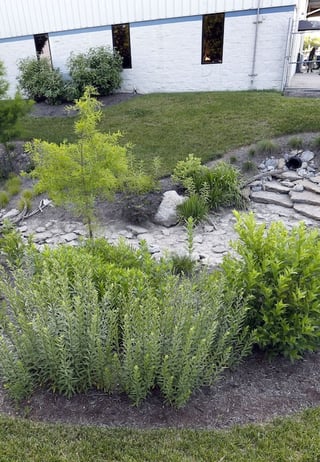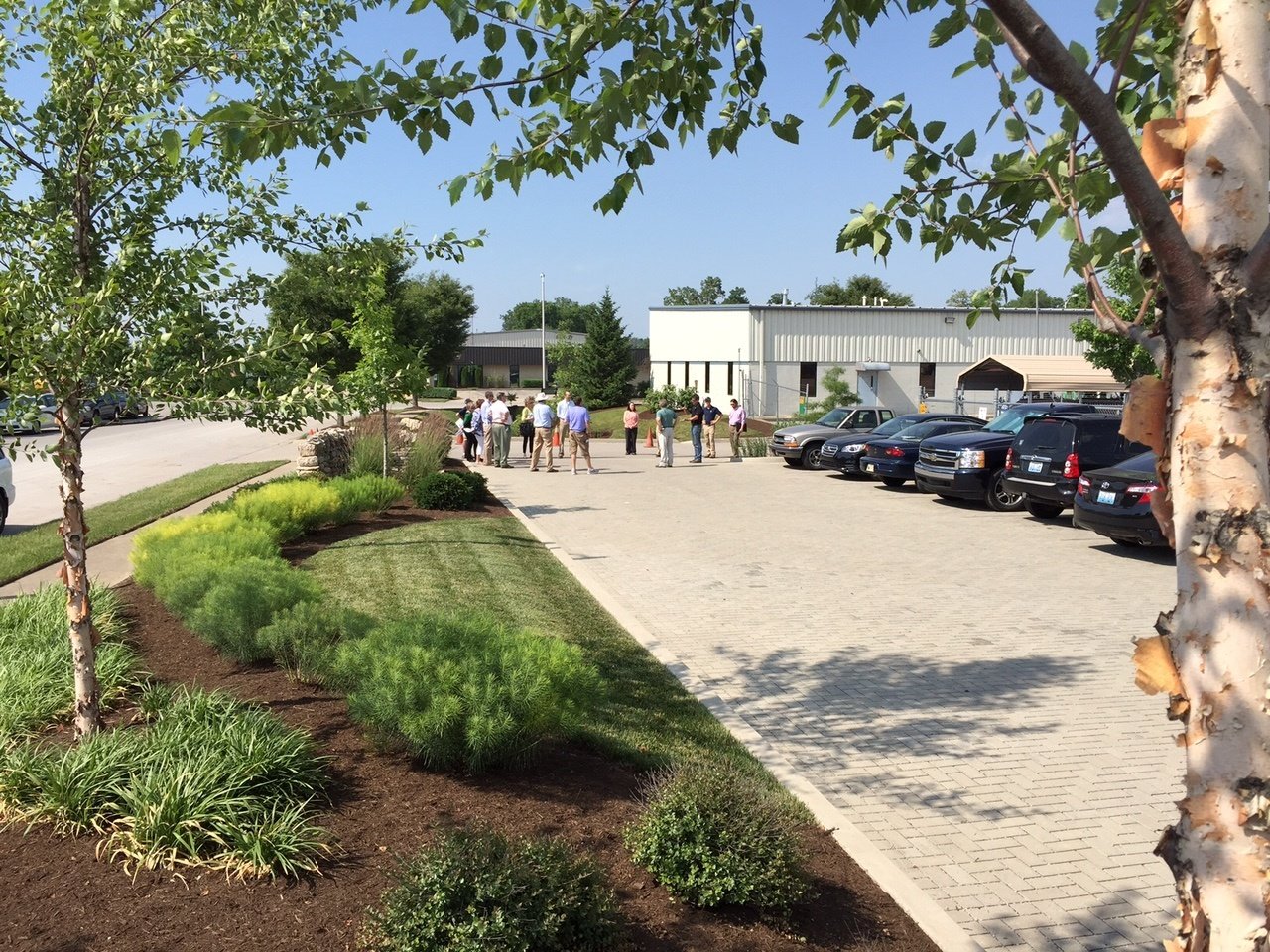Green infrastructure is a specialty type of construction very different than typical landscape construction requiring a unique skill set and expertise. Our team includes experts in horticulture, ecology, design, and construction with decades of experience. Equally important, we believe in educating our clients to help them understand the benefits they can gain from a landscape that does more than look pretty. Those benefits can only be fully realized if a green infrastructure project is properly designed, executed, and maintained.
Rain Garden:
Rain gardens are more complex than simply creating another flower bed on your commercial property. Three common mistakes are not properly grading the space, neglecting the soil, and selecting the wrong types of plants.
 Design: You’ll need to do more than select plants to create a rain garden. Proper design is essential to direct the flow of rainwater into the garden. Rain gardens should be placed away from buildings so that water does not create foundational issues. Without adequate drainage, water can flow toward structures, creating a negative drainage situation. The rain garden should allow water to spread, and berms should include spillways so water can overflow if necessary. If the purpose of the rain garden is for stormwater control, the rain garden will need to be designed by an engineer who accurately calculate factors like rainfall rate. (There are specific guidelines for creating rain gardens that conform to MS4 stormwater standards.)
Design: You’ll need to do more than select plants to create a rain garden. Proper design is essential to direct the flow of rainwater into the garden. Rain gardens should be placed away from buildings so that water does not create foundational issues. Without adequate drainage, water can flow toward structures, creating a negative drainage situation. The rain garden should allow water to spread, and berms should include spillways so water can overflow if necessary. If the purpose of the rain garden is for stormwater control, the rain garden will need to be designed by an engineer who accurately calculate factors like rainfall rate. (There are specific guidelines for creating rain gardens that conform to MS4 stormwater standards.)
Remember, no two rain gardens are exactly alike because our properties are like mini ecosystems that vary in terms of where rainwater falls, flows and collects. That’s why a consultation from an experienced landscape firm that focuses on green infrastructure is so valuable.
Soil: Our Central Kentucky soil tends to consist of clay, which is poor for drainage. Rain gardens require a bioretention soil moisture that contains sand, compost and topsoil. The majority of the mix is sand, which is key for effective drainage. Compost adds nutrients to help plants thrive, as does the topsoil. Include a settling area to allow sedimentation to drop out before entering the main portion of the rain garden. Excessive sediments can clog the constructed soils and prevent percolation.
Plants: The selection of rain garden plants requires understanding what a rain garden is like most of the time. The natural state of a rain garden is one of drought. If the rain garden holds water like a pond, it is not functioning properly. Plants need to be able to tolerate both the flood events after rain and also the drought between storm events. A common mistake is selecting plants that tolerate wet feet but cannot tolerate drought. Choose plants that occur naturally along seasonal flood plains like iris, hibiscus, and joe-pye.
Green Roofs:
The greatest challenge with green roof projects is just getting started. There are two types of green roofs, intensive (more soil and larger plants) and extensive (less soil and low growing plants like sedums). The choice of green roof system depends as much upon the strength of the structure as it does budget. The most common extensive planting system uses trays that include soil and plants. These prefabricated trays usually contain 3 to 6 inches of soil and plants such as sedums that handle exposure to full sun, wind—all of the elements. (That includes pollution, because green roofs are basically catching what’s in the air.)
 Intensive green roof projects are custom built, such as the one on the roof of our headquarters in Lexington, Ky. Our vegetative roof has soil as deep as nine inches so it can support a larger variety of plants and shrubs. Greater soil depth allows for more plant variety and also retains moisture for longer. However, when that heavy soil is on top of a structure, the roof beneath it must be properly engineered with the supports to withstand tons of weight.
Intensive green roof projects are custom built, such as the one on the roof of our headquarters in Lexington, Ky. Our vegetative roof has soil as deep as nine inches so it can support a larger variety of plants and shrubs. Greater soil depth allows for more plant variety and also retains moisture for longer. However, when that heavy soil is on top of a structure, the roof beneath it must be properly engineered with the supports to withstand tons of weight.
Roof-Lite Soil: Regular topsoil is not appropriate for a green roof. You need a lightweight soil that allows for proper drainage. Roof-Lite soil is made of sand, soil and organic material such as compost. Similar to rain garden soil—except lighter—this blend is designed so it does not retain water, which is heavy. More water means more weight.
Plant Care: While low-maintenance plants such as sedums are often selected for green roofs, remember there is no such thing as a no-maintenance plant. We see green roof projects die out fast when plants are neglected. As with like new gardens, new plants on a green roof require care as they are establishing and must be monitored on a continuous basis. The most common cause of planting failures is due to the lack of weeding. The weeds take over and kill out the desired plants.
Permeable Pavers:
Permeable paver systems are a sustainable alternative to typical concrete, asphalt and traditional pavers because they absorb water and reduce run-off. This protects water quality (filtering out sediment and pollution), and reduces the burden on our stormwater infrastructure.

Select Triple-Washed Stone: Other types of stone contain particles and dust that can clog up the porous surface so the permeable pavers do not actually do their job. We see projects fail before they are even installed because of the type of paver material selected. Be sure that permeable pavers are triple-washed stone.
Routine Maintenance: Permeable pavers must be cleaned by using a sweeper or vacuum that lifts dust and particles away from the surface. Again, the idea is to prevent the pavers’ porous surfaces from getting blocked.
Does Your Property Make a Positive Impact?
Let’s talk more about how your commercial Kentucky property can make a positive impact on the environment, step by step, with green infrastructure. Call us any time in Lexington at 859.254.0762, or in Louisville at 502.264.0127. Or, fill out this simple contact form and we’ll get in touch with you.


